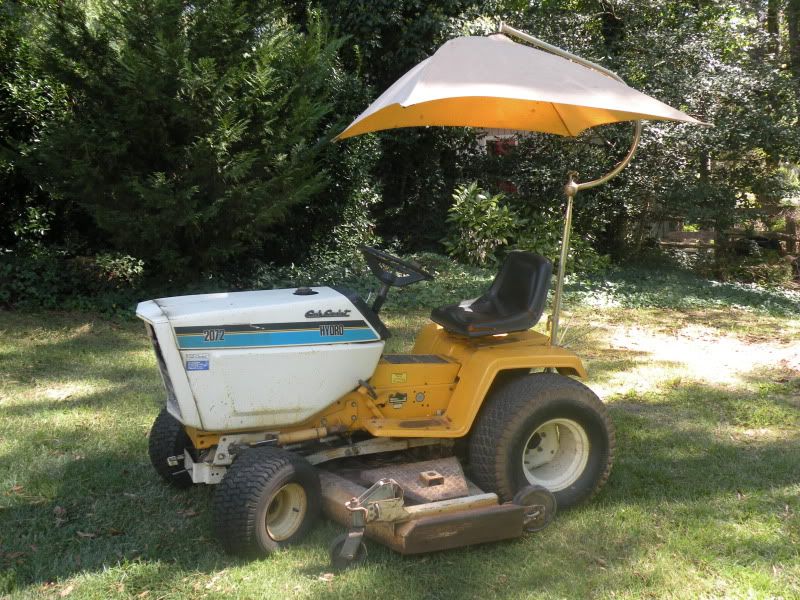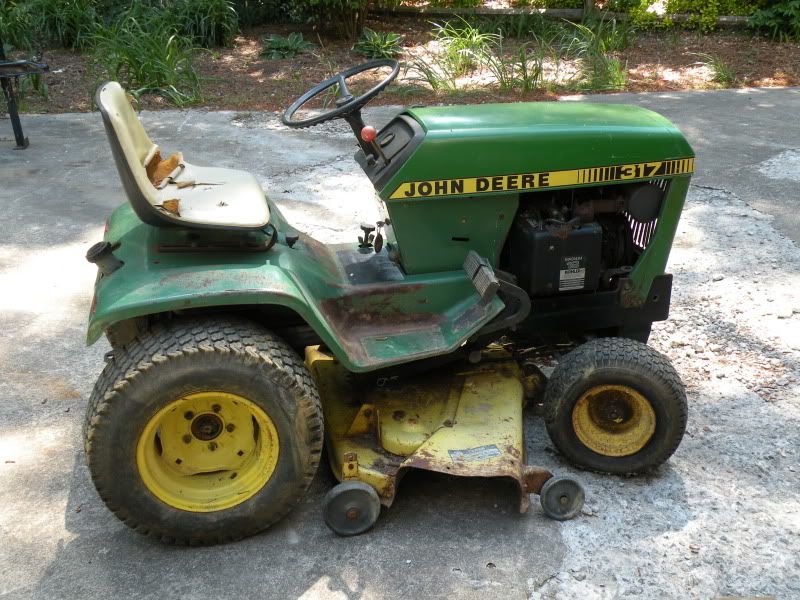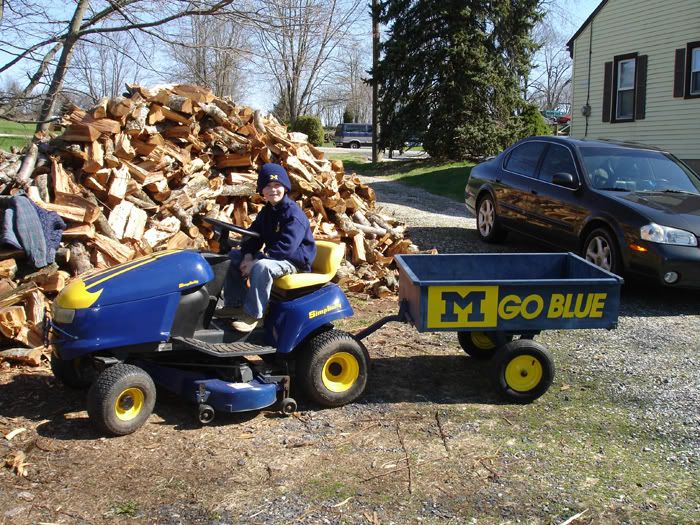You are using an out of date browser. It may not display this or other websites correctly.
You should upgrade or use an alternative browser.
You should upgrade or use an alternative browser.
Lets see some custom lawnmower cutting/hauling setups
- Thread starter ccarpen4753
- Start date

Help Support Arborist Forum:
This site may earn a commission from merchant affiliate
links, including eBay, Amazon, and others.
1grnlwn
ArboristSite Operative
really fast!View attachment 204832
Nuzzy
Trail Gnome
Ah yes. I forgot about your repower. That was a nice Thread and a nice job that you did Nuzz. Maybe you should resurrect it for the newbs.:msp_smile:
Well, I AM considering getting another Allis/Simplicity and knowing my luck, the motor WILL blow up shortly after getting it home, so I might end up doing another repower anyways...


EZRYDER
ArboristSite Operative
Nice JD ccarpen!
That JD is sweet! Looks like new! Are you sure it's 80's? I am restoring a wimpy sears LT 8 lawn tractor (built by Murray in the late 70's ) for wood hauling which I bought for a song. It looks great, little rust which I am fixing and I need a throttle handle assembly. Can't seem to find exact part so hunting for similar. Any help? Haven't tried to haul yet but I am small scale with 1.5 acres which I have been piling up with wood for 20 years and it is time to clean up! Only going to pull a small lawn tractor dump cart though. Also looking to do something with the exhaust situation. It goes in my face. Need to rout it up or back. I can't believe it was originally built to just blow out the front of the tractor. Otherwise everything works great! I'll post pics soon.
That JD is sweet! Looks like new! Are you sure it's 80's? I am restoring a wimpy sears LT 8 lawn tractor (built by Murray in the late 70's ) for wood hauling which I bought for a song. It looks great, little rust which I am fixing and I need a throttle handle assembly. Can't seem to find exact part so hunting for similar. Any help? Haven't tried to haul yet but I am small scale with 1.5 acres which I have been piling up with wood for 20 years and it is time to clean up! Only going to pull a small lawn tractor dump cart though. Also looking to do something with the exhaust situation. It goes in my face. Need to rout it up or back. I can't believe it was originally built to just blow out the front of the tractor. Otherwise everything works great! I'll post pics soon.
ccarpen4753
ArboristSite Operative
thanks ezryder
Thanks, i just repainted it this year. I tell you what for the price compared to an atv/utv you cant beat a good old mower. As far as your parts go,only suggestion i have is to scour the web. I know partstree.com is great for reference, with schematics and part numbers. Might try just a google search for your mower, like sears lt8 parts. Good luck!
Thanks, i just repainted it this year. I tell you what for the price compared to an atv/utv you cant beat a good old mower. As far as your parts go,only suggestion i have is to scour the web. I know partstree.com is great for reference, with schematics and part numbers. Might try just a google search for your mower, like sears lt8 parts. Good luck!
ccarpen4753
ArboristSite Operative
Thanks guys and keep them coming!
I was hoping Whitespider and Nuzzy would post their tractors. Thanks guys truly unique and well built rigs. I had seen theirs in other threads and was hoping to see more. Love seeig all the different brands,setups,adaptations.
I was hoping Whitespider and Nuzzy would post their tractors. Thanks guys truly unique and well built rigs. I had seen theirs in other threads and was hoping to see more. Love seeig all the different brands,setups,adaptations.

$202.29
Oregon Yukon Chainsaw Safety Protective Bib & Braces Trousers - Type A Protection, Dark Grey, Large
Express Shipping ⭐⭐⭐⭐⭐

$26.99 ($0.22 / Foot)
$29.99 ($0.25 / Foot)
VEVOR Double Braided Polyester Rope, 1/2 in x 120 ft, 48 Strands, 8000 LBS Breaking Strength Outdoor Rope, Arborist Rigging Rope for Rock Hiking Camping Swing Rappelling Rescue, Orange/Black
Amazon.com

$337.83
$369.99
WEN Electric Log Splitter, 6.5-Ton Capacity with Portable Stand (56208)
Amazon.com

$15.25
$30.50
FORESTER Professional Arborist Throw Line Kit | Tree Felling Equipment with Arborist Throw Bag | Throw Rope, Throw Weight, Yellow and Red, PP35016
Mac Wholesalers of Missouri LLC

$79.99
ZELARMAN Chainsaw Chaps 8-layer Protective Apron Wrap Adjustable Chainsaw Pants/Chap for Loggers Forest Workers Class A
QUALITY GARDEN & HAND TOOLS

$215.05
$233.19
Weaver Leather WLC 315 Saddle with 1" Heavy Duty Coated Webbing Leg Straps, Medium, Brown/Red
Amazon.com

$225.16
OREGON 295397 Type C (All Round Yukon Chainsaw Protective Trouser, Black, Small
Express Shipping ⭐⭐⭐⭐⭐

$56.99 ($0.38 / Foot)
$69.99 ($0.47 / Foot)
Arborist Rigging Rope Bull Rope Black (1/2 in x 150ft) Polyester Braided Arborist Rope 48 Strands for Tree Work Camping or Swinging…
UIERTIO

$63.99
ZELARMAN Chainsaw Chaps Apron Wrap 8-layer for Men/Women Loggers Forest Workers Protective Chain Saw Pants Adjustable
QUALITY GARDEN & HAND TOOLS

$19.99 ($3.33 / Count)
Firewood Log Splitter 45mm+32mm + 4 Handles (Square + Round + Hex Shank + Small Hex) Wood Log Splitter Easy Splitter Detachable Drill Bit Heavy Duty Electric Drills Screw Cone Driver Removable
JianShiMoQinDianZiShangWuYouXianGongSi
Yeah, but mine ain't as pretty as Nuzzy's is.
ccarpen4753
ArboristSite Operative
this aint no beauty contest,lol
It dont have to be pretty, it just Works! Cudos to Nuzzy for a great looking machine. But both of your tractors are great! I like nice looking machines, but i have a tendancy to be hard on paint jobs. Oh and love the wheel weights and winch, spider. Nuzzy great fab work.
Yeah, but mine ain't as pretty as Nuzzy's is.
It dont have to be pretty, it just Works! Cudos to Nuzzy for a great looking machine. But both of your tractors are great! I like nice looking machines, but i have a tendancy to be hard on paint jobs. Oh and love the wheel weights and winch, spider. Nuzzy great fab work.
Last edited:
zogger
Tree Freak
Well, I AM considering getting another Allis/Simplicity and knowing my luck, the motor WILL blow up shortly after getting it home, so I might end up doing another repower anyways...
post the repower link please!
Nuzzy
Trail Gnome
Yeah, but mine ain't as pretty as Nuzzy's is.
Like that has ever stopped any of us! Haha
Maintenance-wise, I keep up on all my stuff, but I sure do abuse the hell out the equipment I own! Well, maybe abuse isn't the perfect word, but I do work stuff hard. I can assure you the only reason that GT looks even halfway decent is because I stripped and repainted it while waiting for some engine rebuild parts :msp_razz:
I'm a strong believer in function over form, and Whitespider's setup is a great one in my book! People that worry about scratches aren't gonna get much use out of their equipment in the woods :wink2:
post the repower link please!
I guess I never did an actual repower thread here; I had just quoted myself from a Allis/Simplicity forum I'm on. Starts on post #18 http://www.arboristsite.com/firewood-heating-wood-burning-equipment/143468.htm
Turns out I never actually needed to cut the hood. I threw another hood on from my parts tractor and just bent it slightly outward. Hence why some pics have the ugly cut hood and others have it straight.
chopperfreak2k1
Addicted to ArboristSite
whitespider, LOVE your custom 10 is it? i'm a Sears guy too. i run the suburbans and i have many! can't say enough about what you've done with your rig, fantastic!
nuzzy, i am also a firm believer in function over form. your allis is an awesome machine and i'm goin right now to read your repower thread.
nuzzy, i am also a firm believer in function over form. your allis is an awesome machine and i'm goin right now to read your repower thread.
- Joined
- Jan 14, 2002
- Messages
- 4,800
- Reaction score
- 12,596
- Location
- North of Goderich, Ontario, Canada
Nuzzy, my thread titled "My firewood tools" has some pics of a trailer I built a few weeks ago to pull behind my brother in laws Steiner tractor. So far it's working great and is good for smaller mowers.
Guido Salvage
Supreme Saw Whoreder
I had this Cub Cadet 2072 but sold it to a fellow in NC before I moved.

I also have a JD 317 that is has a hydro and power steering as well as triple remotes. I have probably owned 40+ tractors (up to 105 HP) and none of them had triple remotes.

Also have several year old JD 115 plus an old 212.

I also have a JD 317 that is has a hydro and power steering as well as triple remotes. I have probably owned 40+ tractors (up to 105 HP) and none of them had triple remotes.

Also have several year old JD 115 plus an old 212.
woodchuck361
ArboristSite Guru
View attachment 204995View attachment 204996well this is my little mower. she does a great job of cutting the grass. The 54 inch deck makes quick work of my acre and half. My yard is hilly so i filled the tires with automotive windsheild washer fluid to add weight, I also mounted an old stack of 5,20 lbs weights to the front bumper, fabed up a rear 3 point hitch. it works great for pulling my 4x8 trailer, yard drag and leaf rake.
not a very good pic, but i use this quite often to go get a few pieces:msp_cool:

wheelhorse 312-8.
Nice WH. I'm about to buy a 312-8 from my BIL.
This is all I have now:

I'm afraid of burning up the hydro trans.
dustytools
Addicted to ArboristSite
Heres my 1974 Case 446. Gonna put some fluid in the rears and try it out this winter.View attachment 205053
chopperfreak2k1
Addicted to ArboristSite
great lookin tractors guys, keep 'em comin!
EZRYDER
ArboristSite Operative
Would like advice on my Sears LT 8/36 restoration
Luv em all! The best looking color to me is the JD. I am thinking of forging my Sears LT8/36 (I am currently restoring) by doing it up in JD colors. What do you think? The body on my late 70's LT is wonderful for it's age. Just need a little touch up paint and a little welding on the bottom of the grill but it was painted red by a body guy owner a few years ago which I think is better than the original grey but for me the JD green and yellow is the coolest! If I can't get enough hauling power out of it I have to research the possible 10 and 12 HP tecumsa engines that were options in the day for that series and locate one. One of the problems is I can't find any markings on my 8 Hp engine to help find compatible higher powers. I am told by one source that I need to pay attention to shaft length, width and mount pattern. It's a bit above my head as an accountant in the suburbs of Western Suffolk county Long Island NY. Any comments to any of the above are sincerely welcomed.
EZRYDER
Luv em all! The best looking color to me is the JD. I am thinking of forging my Sears LT8/36 (I am currently restoring) by doing it up in JD colors. What do you think? The body on my late 70's LT is wonderful for it's age. Just need a little touch up paint and a little welding on the bottom of the grill but it was painted red by a body guy owner a few years ago which I think is better than the original grey but for me the JD green and yellow is the coolest! If I can't get enough hauling power out of it I have to research the possible 10 and 12 HP tecumsa engines that were options in the day for that series and locate one. One of the problems is I can't find any markings on my 8 Hp engine to help find compatible higher powers. I am told by one source that I need to pay attention to shaft length, width and mount pattern. It's a bit above my head as an accountant in the suburbs of Western Suffolk county Long Island NY. Any comments to any of the above are sincerely welcomed.
EZRYDER
chopperfreak2k1
Addicted to ArboristSite
for hauling a trailer load of wood i think the 8hp should be fine for you. i had an LT10/36 and it had more than enough power for around the yard. your biggest problem might be maintaining traction with such a light machine if hauling heavy loads as was my problem. your previous information of crankshaft length, diameter, and engine mounting bolt pattern was correct. any verticle shaft engine matching these three criteria should work in your application as long as it will clear the hood, steering, battery, etc. share some pix of that little monster!
With small tractors such as these it really ain't so much about the horsepower, it's about traction first and gearing second. If you spin a wheel pulling a heavy load then your tractor already has more HP and torque then it can put on the ground... you have to find a way to put that wasted power on the ground... and adding more HP won't help at all. If your tractor can't get the load moving, pull it up hill, or over rough ground without smoking the belt and killing the engine you need lower gearing... more HP will just chew up the belt faster.
Back in the day they made two types of "yard" tractors...
One was called a "Lawn Tractor", usually a bit lighter built and higher geared, cost less money and mostly intended for mowing yards. There may have been a limited selection of attachments, such as a snow blower for doing the driveway.
The second type was called a "Garden Tractor", they were built heavier and cost more money. Usually there was a long list of attachments... just about anything available for full size tractors, including loaders, plows and whatnot. All these attachments needed power to work, and by supplying lower gearing the operator could balance the percentage of power required by the drive wheels... leaving more power for the attachment. It also allowed the tractor move slowly at full throttle when required, such as using the garden tiller attachment... using full throttle to power the tiller but in low gear the tracker moved at a snails pace, leaving near 100% of the power for the tiller. The low gearing was often a real transmission (instead of some slip-pulley design) with more gears (maybe 7 or 8 instead of 3 or 4), or like my old Sears Custom XL, it had a two-speed axle that allowed super-low gearing throughout the full range of the transmission, including reverse.
Either way, adding a couple more HP to your tractor won't make enough difference to justify the expense and effort.
Back in the day they made two types of "yard" tractors...
One was called a "Lawn Tractor", usually a bit lighter built and higher geared, cost less money and mostly intended for mowing yards. There may have been a limited selection of attachments, such as a snow blower for doing the driveway.
The second type was called a "Garden Tractor", they were built heavier and cost more money. Usually there was a long list of attachments... just about anything available for full size tractors, including loaders, plows and whatnot. All these attachments needed power to work, and by supplying lower gearing the operator could balance the percentage of power required by the drive wheels... leaving more power for the attachment. It also allowed the tractor move slowly at full throttle when required, such as using the garden tiller attachment... using full throttle to power the tiller but in low gear the tracker moved at a snails pace, leaving near 100% of the power for the tiller. The low gearing was often a real transmission (instead of some slip-pulley design) with more gears (maybe 7 or 8 instead of 3 or 4), or like my old Sears Custom XL, it had a two-speed axle that allowed super-low gearing throughout the full range of the transmission, including reverse.
Either way, adding a couple more HP to your tractor won't make enough difference to justify the expense and effort.
Similar threads
- Replies
- 10
- Views
- 446
- Replies
- 1
- Views
- 623
- Replies
- 38
- Views
- 3K












































